Coffee knowledge | grading of defective beans in SCAA boutique coffee
According to the SCAA (American Fine Coffee Association), raw beans are divided into category I and II defects. Before we understand the defective beans, let's take a look at the structure of the coffee fruit.
The structure of coffee fruit

After picking, coffee fruits need to go through a series of processes before they can become what we call coffee raw beans. This series of processes are often referred to as the handling of raw coffee beans or the rough processing of raw coffee beans in the industry.
Coffee fruits from outside to inside are as follows:
❼ peel (exocarp)
❻ pulp (mesocarp)
❺ pectin
❹ parchment (endocarp)
❸ silver (a thin layer between parchment and raw beans, including the midline)
❷ coffee raw bean (endosperm)
❶ midline
Let's first understand what is the "flaw" of raw coffee beans.
A "flaw" is a defect that exists in coffee beans and can change the taste and quality of coffee. And "abortive beans" is commonly known as Quaker beans, that is, roasted beans are obviously lighter in color than normal coffee beans and are not fully developed. SCAA divided the defective beans into two levels, 6 first-level defects and 10 second-level defects.

Common defective beans of raw coffee
All black bean (Full Black)
Features: whole or local raw beans are black and opaque.
Cause of formation: blackening is caused by excessive fermentation, such as fermentation or smelly, dusty odor, mildew and decay.
Whole sour beans. Local sour beans (Full Sour.Partial Sour)
Characteristics: beans are considered sour beans when they appear yellowish brown or reddish brown.
Cause of formation: sour beans are contaminated by bacteria in the process of harvest and treatment.
Mildew damaged bean (Fungus Damage)
Characteristics: yellow-brown reddish-brown spots in the initial stage of mildew-damaged beans indicate that they are eroded by irritant spores.
Cause of formation: mildew damage to beans is usually due to the presence of mold spores on beans, which will cause mold to grow and infect beans when stored at a certain temperature and humidity after harvest.

Worm-eaten bean (Insect damage)
Features: diameter 0.3-1. Smm's small black hole is usually on the inside of the coffee bean.
Cause of formation: in coffee agriculture, insect pests are the most serious, and insects have already drilled into the fruit to breed while the fruit is still on the tree.
Broken bean (Broken bean)
Features: broken beans usually have a dark red area because of oxidation.
Cause of formation: broken beans usually break when dealing with pulp or dry processing, incorrectly correcting the machine and excessive friction or extrusion.
Immature bean (Immature bean)
Features: immature beans can be distinguished from the pale and yellowish green skin or the white spots of the skin.
Reasons for formation: there are many reasons for not fully maturing, inappropriate harvesting of immature fruits and berries that are too late for ripening at higher elevations.
Deformed bean (Deformity beans)
Features: abnormal shape, off-center incision slightly enlarged.
Causes: growth defects, physiological factors.
Shell shape (Shell)
Features: shell beans are separated and deformed from the inside or outside at the same time.
Cause of formation: it is mainly caused by genetic variation.
Floating bean (Floater)
Features: floating beans are particularly white or faded, while raw beans are spotted.
Cause of formation: for processing, this disadvantage is caused by improper storage or drying, which usually leads to discoloration or low bean density.
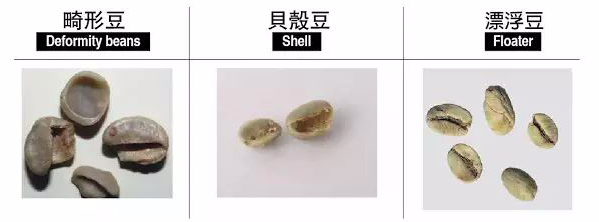
According to the requirements of SCAA boutique coffee:
1. There are no class I defects in 350 g raw bean samples.
2. Deduction of no more than 5 II defects in 350 g raw bean samples.
3. There should not be any "quaker" in 100g coffee cooked beans.
4. The color range of raw coffee beans is pale yellow (light yellow), yellow-green (yellow-green), greenish (partial green), green (green), bluish-green (bluish green) and blue-green (blue-green).
5. Graded supplementary note: if two or more defects occur at the same time, the more serious ones will be dealt with. (for example, if there are local sour beans, but there are also 2 wormholes, then the defects must be classified as local sour beans.)
The deduction in the sample through different classification of defects
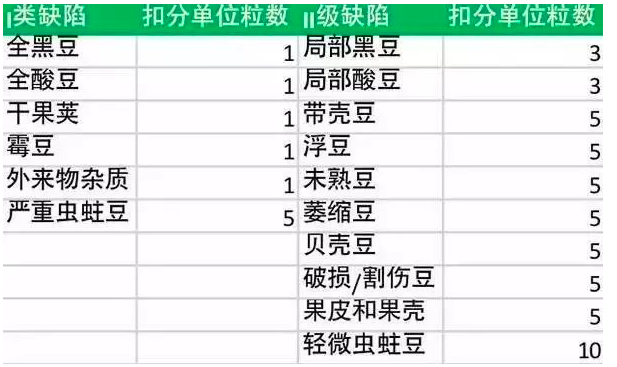
[key hints]
All black beans belong to the first-class defect, one point is deducted when one is encountered, two points are deducted when two are encountered, and one point is deducted for five serious worm-eaten beans, and less than five points are not deducted. Second-level defects deducted more than five points, take local black beans as an example, that is, three local black beans deducted one point, deducted more than five points for non-boutique grade.
Black bean
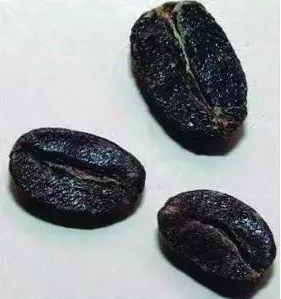
Defect classification: black beans are divided into total black beans and local black beans according to the different proportion of the black part of the whole coffee bean. When the black area is less than 50% of the bean body, it will be treated as a local black bean, otherwise it will be treated as a full black bean.
One full black counts as a Class I defect.
Three local blacks count as an II defect.
Effect on flavor: it can produce uncomfortable fermentation or odor, dirty, moldy, sour and phenolic smell.
Sour bean

Defect classification: sour beans are divided into two categories: total sour beans and local sour beans, the difference is similar to black beans, if less than 50% of the beans belong to local sour beans, otherwise they are all sour beans.
1 the whole sour bean is a kind of I
Three local sour beans can be regarded as an II defect.
Effect on flavor: over-fermented sour taste, disgusting
Moldy bean

Defect classification: one moldy bean is counted as a Class I defect.
Effect on flavor: moldy soil flavor, phenol flavor.
Foreign object

Defect classification: a foreign object is counted as a Class I defect.
Effect on flavor: some foreign substances will affect raw beans and cause defective taste in the cup.
Bean pod

Defect classification: a dried pod counts as a Class I defect
Effects on flavor: fermentation, mildew and phenolic flavor.
6. Moth-eaten beans
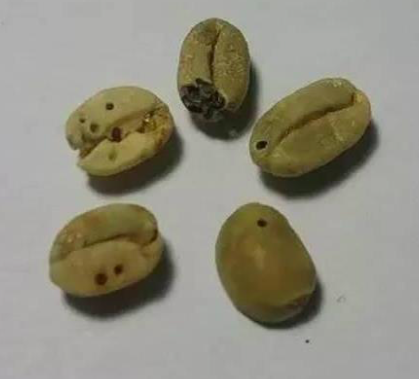
Classification of defects: worms can be divided into serious and slight moths.
Serious wormeaten: there are 3 or more wormholes in the bean body, which is a Class I defect when there are 5 serious wormeaten beans.
Light wormeaten: less than 3 wormholes in the bean body, which is considered an II defect when there are 10 slight wormeaten beans.
Effects on flavor: dirty, sour, phenolic and moldy.
Broken beans

Features: the appearance of raw beans shows mechanical damage wounds such as rupture and fragmentation, and sometimes the edges are black.
Defect classification:
Five broken beans are counted as an II defect.
Effect on flavor: if there is mildew, there is obvious soil mildew, dirty taste, sour taste and fermented taste.
Unripe bean
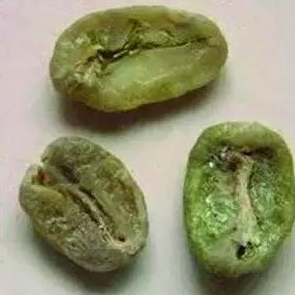
Defect classification: 5 unripe beans are counted as one II defect.
Effect on flavor: grass flavor, straw flavor.
9. Shrunken beans
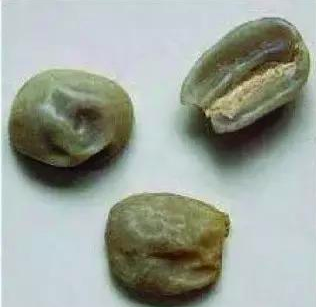
Defect classification: 5 shrunken beans were counted as one II defect.
Effect on flavor: slight grass flavor, straw flavor.
10. Shell beans

Defect classification: 5 shell beans are counted as one II defect.
Effect on flavor: choky taste (shell beans are easy to be scorched or even burned at high temperature during baking because of their low density.
Floating bean
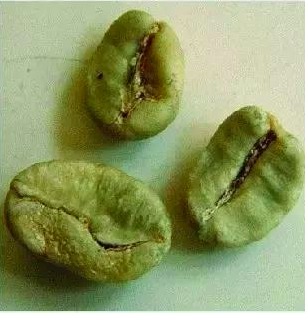
Defect classification: 5 floating beans count as one II defect.
Effect on flavor: according to the degree, there are fermentation flavor, green grass flavor, straw flavor, soil flavor, mildew taste and so on.
Shelled bean

Defect classification: 5 shelled beans are counted as one II defect.
Effect on flavor: woodiness. (if there is a large proportion of shell beans, the woody flavor will be obvious.)
Peel and shell
、

Defect classification: 5 pericarp (shell, or exocarp) is counted as an II defect.
Effect on flavor: if the peel is infected by mold in the cup, it will have a dirty, earthy, moldy, fermented or phenolic flavor.
The above is the basic classification of raw beans, through different defect classification, deduction points in the sample, and finally get no class I defects and II defect deduction points less than 5 points of raw bean samples are high-quality beans.
、
Coffee raw beans are the most important factor affecting flavor. If you want a good cup of coffee, defective beans must be picked out!
Important Notice :
前街咖啡 FrontStreet Coffee has moved to new addredd:
FrontStreet Coffee Address: 315,Donghua East Road,GuangZhou
Tel:020 38364473
- Prev
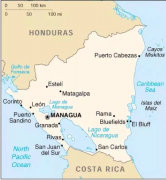
Detailed explanation of coffee producing areas in Honduras
Honduras is located in the north of Central America, facing the Caribbean Sea to the north, the Gulf of Fonseca in the Pacific Ocean to the south, Nicaragua and El Salvador to the east and south, and Guatemala to the west, mostly mountains and plateaus. It covers an area of 112492 square kilometers and the coastline is about 1033 kilometers long. The whole territory, except the coastal plain, is mountainous, with the highest elevation of 3000 meters in the northwest and more than 2400 meters in the south.
- Next

Topic | Why do you like cafes more and more?
Where is it now? What are the plans of the cafe for the weekend? To the cafe? ? ? Why? Nowadays, people really like cafes. What is the charm of cafes that make people more and more like to stay in cafes? The famous French writer Balzac once said: I am not at home, in the coffee shop, not in the coffee shop, on the way to the coffee shop, and the linguist
Related
- Why can American refills for free? The difference between Americano and American drip pot coffee
- Being chased out of the rain in front of Starbucks?! Store: Sheltering from rain under umbrellas poses a safety hazard
- The white moonlight has changed?! Lucky launches "Big Winter Pear American"
- Hand-brewed coffee three-stage method, high-sweet and universal brewing method to share! What does the high sweet water level of hand-brewed coffee mean?
- What is the difference between raw, refined and full espresso coffee? How to extract espresso and taste good?
- A complete list of coffee bean names and their meanings! What is Yejia Shefi coffee? Where is Mantelin coffee?
- What grade does Arida Manor Kaduai coffee beans belong to? What treatment is Arida ASD slow anaerobic sun exposure?
- The milk tea cup becomes smaller?! Overlord Tea Girl launches a new "Return to Yunnan" series
- Accused of selling counterfeit and high-priced coffee beans! Well-known boutique coffee brand "Oukelao" bowed and apologized!
- How to make espresso dumplings? Can I eat coffee and glutinous rice balls together?

